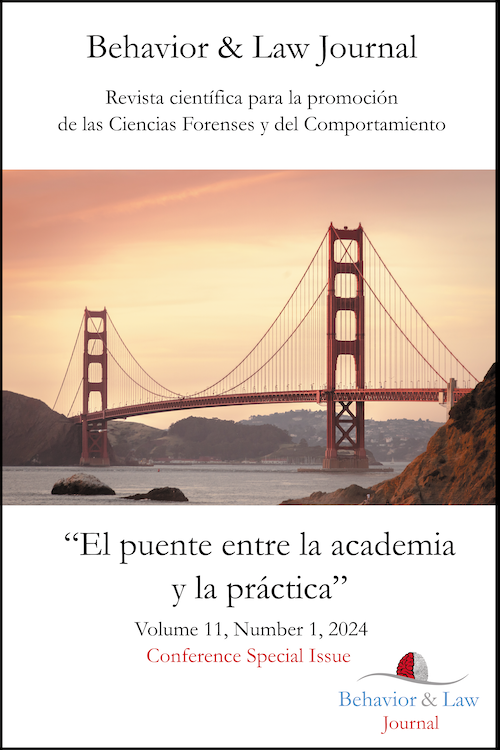Abstract
In this article, the authors analyze the development of predictive criminology in Spain from a strategic perspective, presenting it as an interdisciplinary field at the intersection of applied criminology, data science, and police intelligence. The paper proposes understanding predictive criminology as an integrated institutional intelligence tool that must be developed within robust ethical, legal, and operational frameworks. The analysis examines the Spanish case and its main experiences, comparing them with the international context. The absence of an articulated national strategy is identified as the main weakness, despite existing technical potential. Through a PESTEL prospective analysis and scenario construction, the study identifies the main drivers of the field and outlines three main scenarios: "irregular progress" (trend scenario), "systemic integration" (positive scenario), and "fragmentation and public distrust" (negative scenario). Finally, the technical, operational, ethical, and strategic limitations of these technologies are addressed, warning about risks such as excessive dependence on technology, algorithmic biases, and lack of governance.
References
American Psychiatric Association. (2013). Diagnostic and statistical manual of mental disorders. DSM-5. (5th edn.). https://doi.org/10.1176/appi.books.9780890425596
World Health Organization (2019). International classification of diseases and related health problems (11th ed.). https://icd.who.int/
Amnesty International. (2020). Stop the scan: How Dutch predictive policing technology reinforces discrimination. https://www.amnesty.nl/content/uploads/2020/10/Report_Stop-the-Scan_English.pdf
Angwin, J., Larson, J., Mattu, S., & Kirchner, L. (2016). Machine bias: There’s software used across the country to predict future criminals. And it’s biased against blacks. ProPublica. https://www.propublica.org/article/machine-bias-risk-assessments-in-criminal-sentencing
Brennan Center for Justice. (2020). Predictive policing explained. https://www.brennancenter.org/our-work/research-reports/predictive-policing-explained
Brantingham, P. J., & Brantingham, P. L. (1993). Environment, routine and situation: Toward a pattern theory of crime. In R. Clarke & M. Felson (Eds.), Routine activity and rational choice (pp. 259–294). Transaction Publishers.
Cohen, L. E., & Felson, M. (1979). Social change and crime rate trends: A routine activity approach. American Sociological Review, 44(4), 588–608.
Ensign, D., Friedler, S. A., Neville, S., Scheidegger, C., & Venkatasubramanian, S. (2017). Runaway feedback loops in predictive policing. arXiv preprint, arXiv:1706.09847. https://arxiv.org/abs/1706.09847
European Commission. (2021). Proposal for a regulation laying down harmonised rules on artificial intelligence (Artificial Intelligence Act). https://eur-lex.europa.eu/legal-content/EN/TXT/?uri=CELEX%3A52021PC0206
Ferguson, A. G. (2017). The rise of big data policing: Surveillance, race, and the future of law enforcement. NYU Press. https://nyupress.org/9781479892822/the-rise-of-big-data-policing/
Fundación Cotec. (2023). Gobernar la inteligencia artificial: Hacia una IA más justa y útil para el interés público. https://cotec.es/publicaciones/inteligencia-artificial-en-la-seguridad/
Godet, M., & Durance, P. (2011). Strategic foresight for corporate and regional development. UNESCO – Futuribles International. https://unesdoc.unesco.org/ark:/48223/pf0000211689
González-Álvarez, J. L., Santos-Hermoso, J., & Camacho-Collados, M. (2020). Policía predictiva en España: Aplicación y retos de futuro. Behavior & Law Journal, 6(1), 26–41. https://behaviorandlawjournal.com/BLJ/article/view/20
Lum, K., & Isaac, W. (2016). To predict and serve? Significance, 13(5), 14–19. https://doi.org/10.1111/j.1740-9713.2016.00960.x
Mateos-García, J., & Chica, C. (2023). Gobernar la inteligencia artificial: Hacia una IA más justa y útil para el interés público. Fundación Cotec. https://cotec.es/publicaciones/inteligencia-artificial-en-la-seguridad/
Ministerio del Interior. (2023). Sistema de seguimiento integral en los casos de violencia de género (VioGén). https://www.interior.gob.es/opencms/es/servicios-al-ciudadano/violencia-contra-la-mujer/sistema-de-seguimiento-integral-en-los-casos-de-violencia-de-genero/
Ministerio para la Transformación Digital y de la Función Pública. (2025). El Gobierno da luz verde al anteproyecto de ley para un uso ético, inclusivo y beneficioso de la Inteligencia Artificial [Nota de prensa]. https://digital.gob.es/dam/es/portalmtdfp/comunicacion/sala-de-prensa/comunicacion_ministro/2025/03/2025-03-11/NdPAPLIACM.pdf
Mohler, G. O., Short, M. B., Brantingham, P. J., Schoenberg, F. P., & Tita, G. E. (2011). Self-exciting point process modeling of crime. Journal of the American Statistical Association, 106(493), 100–108.
Observatorio de Contenidos Audiovisuales. (2023). Informe Público de Percepción Social de la Inteligencia Artificial en España. OCAusal. https://www.ocausal.es/wp-content/uploads/2023/07/Informe_IA_Spain_2023.pdf
OECD. (2020). Strategic foresight for better policies: Building effective governance in the face of uncertainty. https://www.oecd.org/governance/strategic-foresight/
O'Donnell, R. M. (2019). Challenging racist predictive policing algorithms under the Equal Protection Clause. New York University Law Review, 94(3), 544–578. https://www.nyulawreview.org/wp-content/uploads/2019/06/NYULawReview-94-3-ODonnell.pdf
Perry, W. L., McInnis, B., Price, C. C., Smith, S. C., & Hollywood, J. S. (2013). Predictive policing: The role of crime forecasting in law enforcement operations. RAND Corporation.
Rangel, F., Montes-y-Gómez, M., Rosso, P., Verhoeven, B., & Daelemans, W. (2018). Automatically detecting false statements in robbery reports. Expert Systems with Applications, 92, 389–401. https://doi.org/10.1016/j.eswa.2017.09.059
Stroud, M. (2020). The minority report: Chicago’s data-driven crime-fighting experiment. Time. https://time.com/4966125/police-departments-algorithms-chicago
The Leadership Conference on Civil and Human Rights. (2021). Predictive policing today: A primer. https://civilrights.org/resource/predictive-policing-today/
The Police Foundation. (2022). Responsible AI for policing: Principles and recommendations. https://www.policingreview.org.uk/papers/policing-ai/
Unión Europea. (2024). Reglamento (UE) 2024/1689 del Parlamento Europeo y del Consejo de 13 de junio de 2024 relativo a normas armonizadas en materia de inteligencia artificial y por el que se modifican determinados actos legislativos de la Unión (Texto pertinente a efectos del EEE). EUR-Lex. https://eur-lex.europa.eu/legal-content/ES/TXT/?uri=CELEX:32024R1689

This work is licensed under a Creative Commons Attribution-NonCommercial-NoDerivatives 4.0 International License.
Copyright (c) 2025 Behavior & Law Journal

